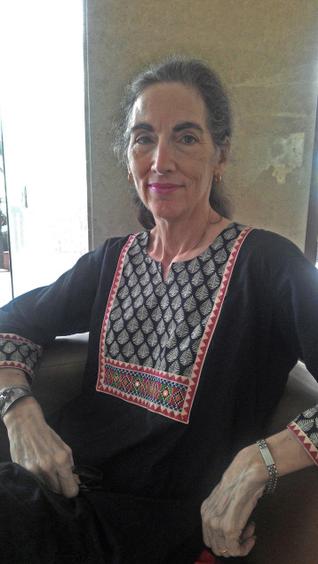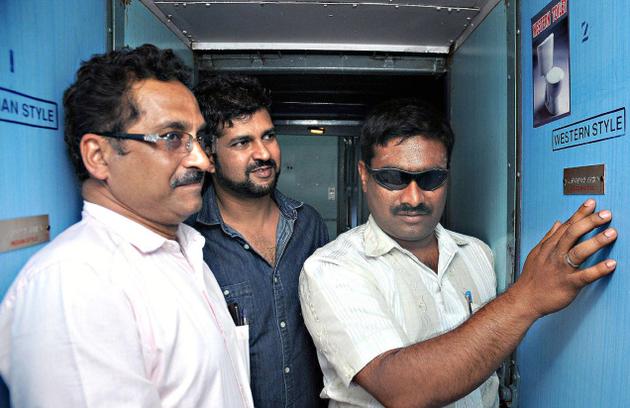Dominating building with Enchanting entrance !
by R.Chandra Prakash

Revathi Prasad left his poverty-ridden homeland at a tender age to distant unknown places, to eke out a living, without a basic sense of local languages and cultures, and ended up in establishing Bombay Anand Bhavan in the year 1921 in Mysore. He belonged to Agarwal community and his ancestors had a petty kirana shop in the village Banail, in present Western Uttar Pradesh. Before coming to Mysore, he had undergone apprenticeship in making sweets and maintaining accounts with a relative in Nagapattnam. Over a period of 40 years between 1921 and 1961, the shrewd business sense of Revathi Prasad, very well-supported by sincere and hard-working Ramachandra Sharma (Masterji), a Brahmin from the same village, went on to make Bombay Anand Bhavan (BAB) a gem in the crown of Makkaji Chowk, the “Kohinoor” of sort.
The two roads, H.R. Street and K.T.Street, joined into a V-shaped triangle from a higher elevation, staring down at a very imposing three-storied, double-winged stately building. Its dominant nature was further enhanced as it was separated from other buildings in the neighbourhood by two lanes on its either sides. Large English name board on the first floor, supplemented by a Kannada name board on the second floor; and a vertical tall neon sign board — BAB — at the centre of the second floor enhanced the building’s dominating character. This building certainly gave the customers a feel of entering a very imposing a mansion of grandeur.
The entrance of BAB was a very powerful commercial proposition and complimented the business carried on inside. BAB had three commercial outlets in the front. First, a Beedi Shop on the left of the entrance. Second, the Sweet Meat Stall on the right. One had to climb four wide but comfortable steps between them to enter the Hotel. Third, on the extreme right, besides the Sweet Meat Stall, there was a Newspaper shop.
The Beedi Shop and Balakrishna
The outer periphery of the Beedi Shop was semi-circular in shape. At the outer edge of the shop there was highly polished two parallel brass pipe railings. There was glass and wood showcase behind the brass railings. On the wall of the shop there were wooden shelves with small partitions. Here one found cigarettes of all brands — Wills, Players, Passing Show, Berkley, Scissors, Blue Navy Cut, Char Minar and, of course, that sweet smelling Marcopolo in a brown blackish tin box! Some expensive cigarettes such as Players and Wills were available in paper packets as also round tin boxes. Biscuits of every type and brand, including Milk Maid brand Glucose biscuits with its own special mild sweet fragrance in waxed cardboard packing. They were imported from Australia in those days. Hair oils of different brands, Horlicks and perfumes were also on display. One also saw the colourful key chains, nail cutters, hanging on hooks on the partition boards of the shelves, so also the colourful cigar lighters, purses and, of course, the metallic boxes for keeping cigarettes.
Also available were the beedis of all brands in paper wrapped small bundles of 25 beedies — Mangalore Ganesh beedi, Puttu Shet beedi, Peer beedi, Hari Bhai red thread, Hari Bhai green thread; and, of course, Cuban Cigar wrapped in transparent sheets and stacked in thin plywood boxes. Match boxes of all varieties and sizes and not to forget very popular brand of Cheeta Fight, Snuff powders – Ambal and Andal brands in small tin canisters were available.
One could also find aerated soda, kept in watered wooden round crates to keep the bottles cold and the contents fresh. There was the very popular Goli [glass ball] Bottled Soda. One could get Orange, Lemon and Cola Goli soda as well. The metal-capped drinks were a bit expensive and Goli sodas were cheaper and very popular.
Balakrishna, a very devout Kaali Bhakta from Kerala, was employed as its salesman. He was a very lean person but had long, dangling, coiled and well oiled hair grown in honour of Kaali. He performed multiple tasks sitting cross-legged on an elevated seat on the eastern side small corner of the shop. Making a Paan ( made out of betel leaf) was his speciality. He would mix various ingredients stored in different boxes and bottles of varied shapes and dimensions, as per the need of a given customer. Scented tobacco, more so Baba Jarda of varying potency was put only on special requests for an extra charge. What an expertise Balakrishna had in this task. Later, his younger brother Mani joined him. Subsequently, both of them set up their own Beedi Shop near the Silver Jubilee Clock Tower.
On the right hand corner, just beside the seat of Balakrishna, a coir rope with burning tip hanged, kerosene lamp with lighted wicks and box containing the cut pieces of cigarette cardboard packets to help light the beedies and cigarettes were fixed to the wooden pillar.
This small, heavily loaded with convenience goods Beedi Shop supplemented the culinary delight inside the hotel. It was by habit that people chewed Paan and smoked Beedi, Cigarette or Cigar after the sumptuous meal in the hotel.
Sweet-meat Stall and the “Malavalli Boys”
Sweet-meat was a special area of interest for the owner for two reasons. He was the original promoter of such North Indian sweets to Mysore and Mysoreans. Unlike the other eatables, sweet-meat is a purchase for emotional and compulsive satisfaction of the customers.
BAB’s sweet-meat stall was a rectangular shop right at the centre of the building, perched over the footpath at a height of about two-and-half-feet above the ground. At the back end of the shop was a huge mirror in a teakwood frame, in a slanted position, top portion projecting a bit outward and lower portion pushed-in. This gave a special angle to the mirror and also the display. Mirror magnified the dimension of the shop and its contents, apart from giving more than life-size look to the items on display due to bright lighting from the roof of the stall. Each sweetmeat was specially arranged on a large stainless steel plate and silver foils were stuck to each one of them. These large plates of sweet-meat were arranged on white marble steps, which gave them maximum exposure to the customer standing at the lower end of the shop. Savouries were arranged at lower steps. There were two seats on either sides of the shop from where two salesmen attended to the customers during rush hours.
Bombay Anand Bhavan sweets were prepared with pure ghee and had earned fame all over the State. The credit should also go Linga, the specialist in making sweets and Chenna, the specialist in making crisp and mouth-watering savouries. Both of them were middle-aged and came from villages near Mallavalli. They always proclaimed proudly that they were “Malavalli ka hudugas – the boys.” They were ably supported by Murugesh, who supplied raw materials to these two master-chefs. Each of them had very interesting personalities of their own.
Newspaper Shop and Jinarajaiah
When a Newspaper and Book Shop was opened in the BAB building, there were not many such shops in Mysore. It was a shop of small width but large length with a large glass frontage. This was rented by Raja Rao of Newspaper House-fame but given to one Jinarajaiah to run it on his behalf. Jinarajaiah was a sturdy looking and very hard working person. Every day he extended the shop by a foldable tin platform on which he displayed his newspapers, magazines and even books. He would spend couple of hours in the day in arranging his wares in the morning and putting them back into stacks in the evening. He was very friendly with the customers and even suggested which magazine or book would be of interest to them. Gradually he built up a very credible clientele. Young and old gentlemen and even a few female clients came to this shop to satisfy their hunger for news and knowledge. Reading was the main source of knowledge in those days. TV was unheard of. On the days of release of new Kannada books there would be huge crowds waiting for the bundles to be opened. Such was the magnetic personality of Jinarajaiah.
Newspapers of all hues from English Madras Mail to Times of India, The Hindu to Deccan Herald; Kannada Thai Naadu to Prajavani; Tamil Dina Tanti to Dina Mani; Hindi Hidustan to Navabharat Times; and even one or two Malayam, Telugu and Gujarati newspapers were available. Those were the heydays of political and cultural upheaval in the Madras State, and everyday large crowds of patrons of language and politics back home used to wait for the arrival of Dina Tanti by afternoon train.
Prajamatha, Koravanji and later on Sudha and Kasturi became the popular Kannada magazines. In Tamil, Kumudam, Kalki and Kadir were popular. On the days when Narasimhaiah’s detective book and the books by Tarasu or Anakru were released, there used to be huge crowds at the shop. Posters were hung at the shop announcing the date of release of these books. The shop attracted Kannada writers, intellectuals, professionals and artists. Artist Tippeswamy was a regular there. Weeklies and fortnightlies from England and children’s cartoon magazines like Lion and Tiger were also available. Sold on stealth were pornography and sun bathers — naturalists, photo magazines. Later on, may be out of financial compulsions, even the cheap porno books and booklets in Kannada were sold here.
Jinarajaiah is said to have committed suicide due to some domestic reasons. If it were so, it is an unfortunate end of a very passionate and knowledgeable workaholic.
These three shops at the entrance of Bombay Anand Bhavan by themselves were very important and lucrative commercial enterprises. They were benefited by the large clientele of BAB and at the same time they built their own categories of customers. Jointly they generated great business and intellectual activities in Makkaji Chowk.
[Makkaji Chowk-5: Bombay Anand Bhavan (Part – II) will recall the hotel business inside the BAB building]
source: http://www.starofmysore.com / Star of Mysore / Home> Feature Articles / Sunday – January 31st, 2016










